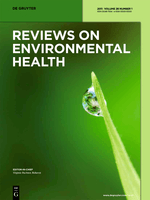
REVIEWS ON ENVIRONMENTAL HEALTH
Scope & Guideline
Uniting disciplines to tackle environmental health challenges.
Introduction
Aims and Scopes
- Environmental Pollution and Health Risks:
The journal emphasizes the relationship between various forms of environmental pollution—such as air, water, and soil contamination—and their associated health risks, including chronic diseases and acute health effects. - Toxicological Assessments:
A significant focus is placed on toxicological evaluations of various chemicals, including heavy metals, pesticides, and emerging pollutants, assessing their effects on human health through systematic reviews and meta-analyses. - Epidemiological Studies:
The journal often publishes epidemiological studies that investigate the prevalence of health conditions linked to environmental exposures, providing insights into the public health implications of environmental factors. - Innovative Remediation and Mitigation Strategies:
Research on innovative strategies for pollution remediation and health risk mitigation is highlighted, showcasing advancements in technology and practices aimed at improving environmental health. - Interdisciplinary Approaches:
The journal promotes interdisciplinary research that integrates environmental science, public health, toxicology, and policy, reflecting a holistic view of environmental health challenges.
Trending and Emerging
- Impact of Climate Change on Health:
Recent publications have increasingly focused on the health implications of climate change, including air quality, heat stress, and the spread of infectious diseases, highlighting the urgent need for research in this area. - Microplastics and Environmental Health:
Research on microplastics has gained significant attention, focusing on their sources, health impacts, and potential mitigation strategies, reflecting growing public concern over plastic pollution. - One Health Approach:
The integration of the One Health concept, which connects human, animal, and environmental health, is emerging as a key theme, emphasizing the interconnectedness of health issues across different domains. - Mental Health and Environmental Factors:
There is an increasing trend in exploring the relationship between environmental factors, such as air quality and green spaces, and mental health outcomes, showcasing the importance of environmental contexts in psychological well-being. - Health Effects of Emerging Contaminants:
Research on emerging contaminants, including pharmaceuticals, personal care products, and industrial chemicals, is on the rise, addressing the need to understand their health effects in modern environments.
Declining or Waning
- Traditional Toxicology Studies:
There has been a noticeable decrease in studies focusing exclusively on traditional toxicology without the integration of epidemiological or environmental context, as the field moves towards more holistic assessments of health impacts. - Limited Scope of Chemical Exposures:
Research specifically targeting isolated chemical exposures, such as single heavy metals or specific pesticides, seems to be waning in favor of more comprehensive studies that consider mixtures and cumulative effects of multiple pollutants. - Geographical Limitations in Studies:
There is a declining interest in studies that focus solely on specific geographical regions without broader implications or comparisons, as the journal encourages a more global perspective on environmental health issues. - Narrow Focus on Historical Data:
Research centered primarily on historical data without contemporary relevance or implications for current public health challenges appears to be less frequently published, as the journal shifts towards more current and actionable research. - Overemphasis on Electromagnetic Fields:
The focus on health effects associated with electromagnetic fields, while still relevant, shows signs of decline as more diverse environmental health topics gain attention.
Similar Journals
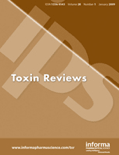
Toxin Reviews
Exploring the Complexities of ToxinsToxin Reviews is a premier academic journal focused on the critical field of Toxicology, published by Taylor & Francis Inc. Established with an aim to foster research and disseminate knowledge, this journal has been pivotal since its inception in 1982 and continues to be a leading platform for both emerging and established researchers. With an impressive impact factor and ranked in the 75th percentile among its peers in the Scopus categories, it serves as an essential resource for scientists, practitioners, and students interested in understanding the complexities of toxins and their effects on health. The journal provides an Open Access platform, enhancing visibility and accessibility of research findings to a broader audience. Covering a wide scope, Toxin Reviews plays a vital role in bridging gaps between toxicological research and practical applications, ensuring that rigorous scientific inquiry translates into real-world solutions.
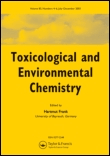
TOXICOLOGICAL AND ENVIRONMENTAL CHEMISTRY
Exploring the impacts of pollutants on our environment and well-being.TOXICOLOGICAL AND ENVIRONMENTAL CHEMISTRY is a pivotal journal published by Taylor & Francis Ltd, addressing critical intersections between environmental chemistry and toxicology since its inception in 1979. With its ISSN 0277-2248 and E-ISSN 1029-0486, the journal serves as a platform for rigorous research and innovative methodologies in pollution control, health implications of environmental chemicals, and the broader spectrum of toxicological studies. Although it currently does not offer open access, the journal's impact in the field is underscored by its Category Quartiles rankings in 2023, placing it in Q3 across Environmental Chemistry, Health, Toxicology and Mutagenesis, and Pollution categories. Furthermore, its Scopus rankings reveal its significant role within the scientific community, specifically in areas such as Environmental Science and Toxicology. The journal aspires to foster multidisciplinary dialogue and advance knowledge that contributes to environmental sustainability and public health, making it an essential resource for researchers, professionals, and students dedicated to these fields.

Revista de Salud Ambiental
Championing Open Access to Environmental Health KnowledgeRevista de Salud Ambiental is a prestigious scientific journal dedicated to advancing knowledge in the field of environmental health. Published by the SOC ESPANOLA SANIDAD AMBIENTAL, this Open Access journal has been providing free access to its articles since 2001, ensuring that critical research on environmental influences on public health is widely available to researchers, professionals, and students worldwide. With an ISSN of 1577-9572 and E-ISSN 1697-2791, the journal covers a broad range of topics including environmental toxins, pollution management, and sustainable public health practices. Its commitment to high-quality research is reflected in its rigorous peer-review process, aiming to drive significant advancements in environmental health science. By promoting interdisciplinary collaboration and dissemination of impactful research, Revista de Salud Ambiental plays a vital role in shaping environmental health policies and practices, making it an essential resource for anyone invested in the future of public health.

International Journal of Occupational Medicine and Environmental Health
Elevating discourse on pressing health and environmental challenges.The International Journal of Occupational Medicine and Environmental Health is a distinguished journal dedicated to advancing the fields of occupational medicine and environmental health. Published by NOFER Institute of Occupational Medicine in Poland, this open-access journal has been providing a platform for innovative research since 2011. With an ISSN of 1232-1087 and an E-ISSN of 1896-494X, it allows for wide dissemination of findings that address contemporary challenges in public health, occupational settings, and environmental issues. The journal has established itself as a vital resource, achieving a Q3 ranking in both Medicine (miscellaneous) and Public Health, Environmental and Occupational Health categories as of 2023, reflecting its commitment to quality and relevance. With a Scopus rank of #295 out of 665 in its domain, it places in the 55th percentile, affirming its growing impact within the scientific community. Researchers, professionals, and students seeking to enhance their knowledge and contribute to the discourse will find the rich content and comprehensive studies presented in this journal invaluable. Explore cutting-edge research from 1994 to the present, and join the conversation on occupational and environmental health issues that profoundly affect global communities.

Environmental Health
Bridging Science and Policy for a Healthier PlanetEnvironmental Health is a premier, peer-reviewed journal dedicated to advancing knowledge in the interdisciplinary field of environmental health. Published by BMC since 2002, this Open Access journal aims to disseminate impactful research that addresses the critical intersections between environmental factors and public health. With its impressive stature as a Q1 journal in key categories, including Health, Toxicology and Mutagenesis, Medicine (miscellaneous), and Public Health, Environmental and Occupational Health, it ranks within the top tier of its field, boasting significant visibility and a high impact factor as demonstrated by Scopus rankings. Scholars and practitioners alike benefit from its well-rounded approach and commitment to bridging science and policy, making it essential reading for anyone invested in understanding and mitigating environmental health risks. The journal is based in the United Kingdom, with a focus on promoting global accessibility to its findings.
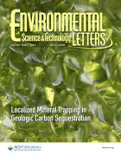
Environmental Science & Technology Letters
Transforming research into actionable environmental solutions.Environmental Science & Technology Letters, published by the American Chemical Society, stands as a premier journal in the realm of environmental science and technology, focusing on pivotal studies that address pressing environmental challenges. With an impressive Q1 ranking in multiple categories including Ecology, Environmental Chemistry, and Pollution, this journal maintains a position of excellence within its field, achieving Scopus ranks that place it in the top percentile of Environmental Science disciplines. Although not open access, Environmental Science & Technology Letters offers vital insights and cutting-edge research that contribute significantly to the understanding and management of environmental issues. The journal’s objectives include disseminating ground-breaking findings and promoting discussions that lead to sustainable solutions. With convergence from 2013 to 2024, it continues to serve as an essential resource for researchers, professionals, and students committed to advancing knowledge and innovation in environmental science.
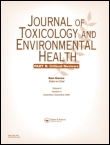
JOURNAL OF TOXICOLOGY AND ENVIRONMENTAL HEALTH-PART B-CRITICAL REVIEWS
Unveiling the complexities of environmental health and toxicology.Welcome to the JOURNAL OF TOXICOLOGY AND ENVIRONMENTAL HEALTH-PART B-CRITICAL REVIEWS, a prestigious publication under TAYLOR & FRANCIS INC based in the United Kingdom. With an impressive impact factor and ranked in the Q1 category for both Health, Toxicology and Mutagenesis, and Toxicology, this journal provides critical insights into the fields of toxicology and environmental health. Since its inception in 1998, it has become a key resource for researchers, professionals, and students, offering rigorous peer-reviewed articles that synthesize and critically appraise current knowledge in the discipline. The journal is recognized globally, ranking #5 in Toxicology and #12 in Environmental Science according to Scopus, highlighting its crucial role in advancing research and understanding in these essential areas. The journal also embraces open access options, making it easier for a broader audience to access vital research findings. Engage with the latest developments and critical analyses that are shaping the future of environmental health and toxicology by exploring our comprehensive collection of reviews and articles.

PUBLIC HEALTH REVIEWS
Leading the Charge in Public Health InnovationPUBLIC HEALTH REVIEWS, published by FRONTIERS MEDIA SA in Switzerland, serves as a premier platform for disseminating essential research and reviews in the field of public health. With an Open Access policy implemented since 2015, this journal makes significant contributions to the global body of public health knowledge, ensuring unrestricted access to its comprehensive articles. Recognized for its excellence, PUBLIC HEALTH REVIEWS boasts an impressive 2023 ranking in the Q1 quartile for both Community and Home Care and Public Health, Environmental and Occupational Health, placing it among the top journals in its category. Its Scopus rankings further affirm this status, with the journal occupying the 1st rank in its community care category, showcasing its influence and reach. Researchers, professionals, and students alike benefit from its rigorously vetted articles, capable of shaping policies and informing practices essential for public health improvement. Whether you are looking to deepen your understanding of contemporary health issues or engage with the forefront of public health research, PUBLIC HEALTH REVIEWS is an indispensable resource.
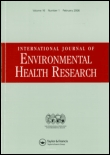
INTERNATIONAL JOURNAL OF ENVIRONMENTAL HEALTH RESEARCH
Exploring the Nexus of Environment and HealthINTERNATIONAL JOURNAL OF ENVIRONMENTAL HEALTH RESEARCH, published by Taylor & Francis Ltd, serves as a cornerstone for interdisciplinary research focusing on the crucial intersections of environmental science and public health since its inception in 1991. With an ISSN of 0960-3123 and an E-ISSN of 1369-1619, the journal spans diverse topics related to environmental health, toxicology, and pollution science, holding high ranks in 2023 such as Q2 in Pollution and Public Health, showcasing its vital contributions to the field. Researchers will appreciate its robust platform as it features rigorous peer-reviewed articles aimed at unveiling the complexities of human health in relation to environmental factors. While the journal maintains a traditional access model, it ensures broad dissemination of high-quality research works. As a reputable source for both emerging and established scholars, the International Journal of Environmental Health Research offers critical insights and advancements pivotal to fostering a healthier planet.
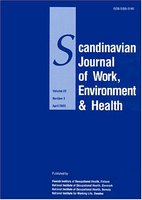
SCANDINAVIAN JOURNAL OF WORK ENVIRONMENT & HEALTH
Innovating solutions for healthier work environments.SCANDINAVIAN JOURNAL OF WORK ENVIRONMENT & HEALTH, published by the Scandinavian Journal Work Environment & Health, is a leading platform dedicated to advancing research in the fields of public health, environmental health, and occupational health. Established in 1975 and set to continuously evolve until 2024, this journal serves as a vital resource for scholars, practitioners, and policymakers concerned with workplace health and safety issues. Notably, it holds an impressive Q1 ranking in its category, and is positioned in the top 10% (90th percentile) of its field according to Scopus rankings, affirming its significance and impact within contemporary research. With a commitment to rigorous peer-review, the journal provides open access to cutting-edge studies, promoting knowledge dissemination and collaborative dialogue among professionals. As the landscape of work environments increasingly intersects with health outcomes, the SCANDINAVIAN JOURNAL OF WORK ENVIRONMENT & HEALTH remains an essential reference point for all those aiming to enhance workplace health criteria and public well-being.